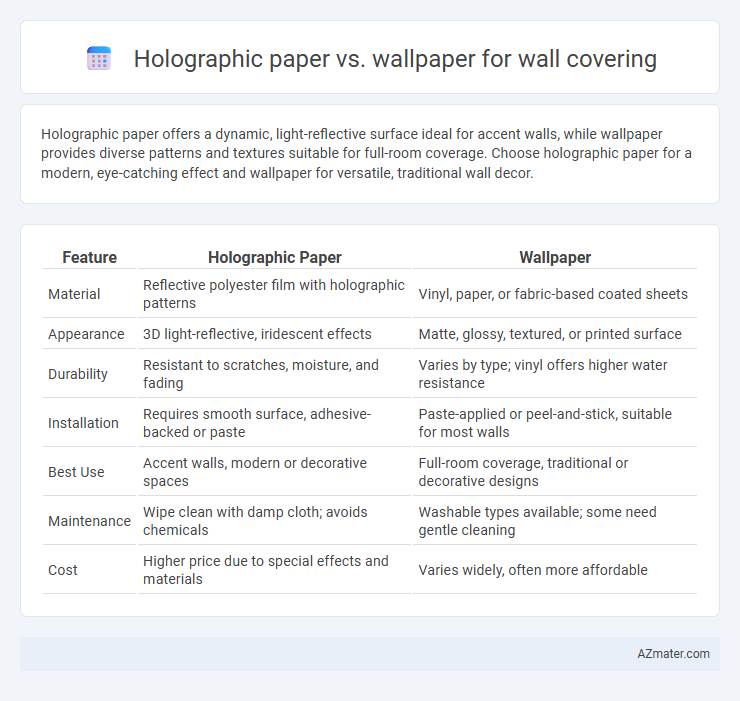Holographic paper offers a dynamic, light-reflective surface ideal for accent walls, while wallpaper provides diverse patterns and textures suitable for full-room coverage. Choose holographic paper for a modern, eye-catching effect and wallpaper for versatile, traditional wall decor.
Table of Comparison
| Feature | Holographic Paper | Wallpaper |
|---|---|---|
| Material | Reflective polyester film with holographic patterns | Vinyl, paper, or fabric-based coated sheets |
| Appearance | 3D light-reflective, iridescent effects | Matte, glossy, textured, or printed surface |
| Durability | Resistant to scratches, moisture, and fading | Varies by type; vinyl offers higher water resistance |
| Installation | Requires smooth surface, adhesive-backed or paste | Paste-applied or peel-and-stick, suitable for most walls |
| Best Use | Accent walls, modern or decorative spaces | Full-room coverage, traditional or decorative designs |
| Maintenance | Wipe clean with damp cloth; avoids chemicals | Washable types available; some need gentle cleaning |
| Cost | Higher price due to special effects and materials | Varies widely, often more affordable |
Introduction to Holographic Paper and Wallpaper
Holographic paper features a unique multidimensional surface that reflects light to create shimmering, color-shifting effects, making it an innovative choice for wall covering. Wallpaper, traditionally made from paper or vinyl, offers a wide array of patterns and textures designed to enhance room aesthetics and provide durable surface protection. Both materials serve decorative purposes but differ in visual impact and application, with holographic paper providing a futuristic, dynamic finish compared to the classic, customizable designs of wallpaper.
Differences in Material Composition
Holographic paper is made from synthetic polymers embedded with micro-prismatic patterns that refract light to create a shimmering, multidimensional effect, whereas wallpaper typically consists of paper or vinyl materials designed primarily for print or texture. The plastic-based holographic paper enhances durability and water resistance compared to traditional wallpaper, which may absorb moisture and wear over time. These fundamental differences in material composition impact installation methods, longevity, and visual appeal in interior wall coverings.
Visual Impact and Aesthetic Effects
Holographic paper creates a dynamic visual impact through its shifting colors and light-reflective properties, offering an eye-catching, futuristic aesthetic ideal for accent walls or modern interiors. Wallpaper provides a broader range of textures, patterns, and finishes that deliver consistent and versatile aesthetic effects, suited for traditional or sophisticated design themes. Choosing holographic paper enhances vibrancy and movement, while wallpaper ensures cohesive style and depth in wall coverings.
Durability and Long-Term Performance
Holographic paper offers moderate durability with a unique reflective finish but tends to be less resistant to scratches and moisture compared to traditional wallpaper. Wallpaper, especially vinyl-coated types, provides superior long-term performance due to its robustness against wear, tear, and humidity. Choosing wallpaper ensures greater longevity and easier maintenance in high-traffic or damp environments.
Installation Process Comparison
Holographic paper installation requires precise alignment to maintain the reflective effect, often involving careful smoothing to avoid air bubbles and ensure seamless light dispersion. Wallpaper installation generally allows for easier handling with standard paste application and is more forgiving of minor misalignments due to its matte or patterned surface. Both materials demand surface preparation, but holographic paper typically needs a smoother and cleaner wall to optimize its visual impact.
Maintenance and Cleaning Requirements
Holographic paper requires delicate handling with a soft, dry cloth to avoid damaging its reflective surface, while wallpaper generally tolerates gentle wiping with a damp sponge and mild detergent for routine cleaning. Both materials demand prompt attention to spills to prevent stains, but holographic paper is more susceptible to scratches and moisture, making it less ideal for high-traffic or humid areas. Wallpaper offers a more durable and low-maintenance option with greater resistance to wear, making it preferable for long-term wall covering solutions.
Environmental and Sustainability Factors
Holographic paper often contains synthetic materials and metallic foils, leading to limited recyclability and increased environmental impact compared to traditional wallpaper made from renewable fibers and eco-friendly inks. Wallpaper options with sustainable certifications such as FSC or GREENGUARD ensure lower VOC emissions and responsible sourcing, enhancing indoor air quality and reducing carbon footprint. Choosing wallpaper with biodegradable or recyclable properties significantly promotes environmental sustainability, unlike most holographic papers that contribute to waste and pollution.
Cost Considerations and Budget
Holographic paper generally has a higher upfront cost than traditional wallpaper due to its specialized manufacturing process and unique visual effects, making it a premium option for wall covering. Wallpaper offers a more budget-friendly solution with a wide range of price points, catering to various financial plans and making it accessible for large-scale projects. When considering long-term expenses, holographic paper may also require careful installation and maintenance, potentially increasing overall costs, whereas wallpaper is typically easier and cheaper to replace or repair.
Popular Applications and Trends
Holographic paper offers vibrant, reflective surfaces ideal for accent walls in modern retail spaces, event venues, and creative offices, creating dynamic visual effects that attract attention and enhance brand identity. Wallpaper remains a popular choice for residential and hospitality interiors due to its wide variety of textures, patterns, and durability, often incorporating eco-friendly materials and custom prints to suit diverse decor styles. Current trends show rising demand for holographic paper in experiential marketing and digital art installations, while wallpaper trends focus on sustainable production and nature-inspired motifs for wellness-focused environments.
Which Wall Covering Is Right for You?
Holographic paper offers a dynamic, light-reflective surface ideal for creating visually striking, futuristic interiors, while wallpaper provides a broader range of textures, patterns, and durability suited for long-term decor. Consider holographic paper for accent walls or modern spaces needing a unique, luminous effect, whereas wallpaper works better in traditional or high-traffic areas due to its versatility and ease of maintenance. Your choice depends on the desired aesthetic impact, room function, and installation environment.

Infographic: Holographic paper vs Wallpaper for Wall covering
 azmater.com
azmater.com